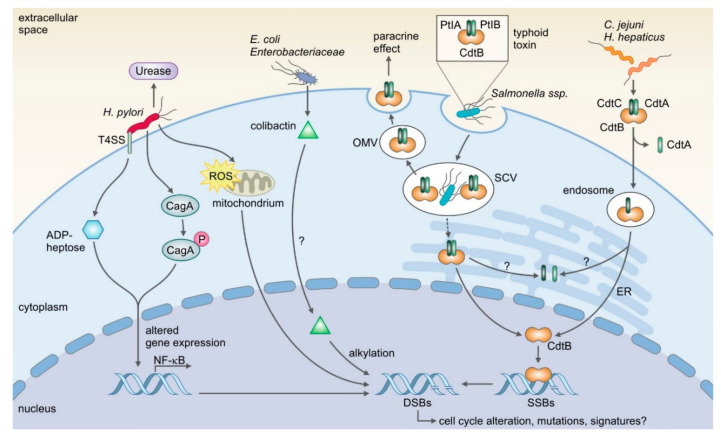Figure 2.
Overview of microbes and their specific virulence factors that can induce DNA damage. H. pylori’s type IV secretion system (T4SS) is known to be crucial for induction of DNA damage. The injected effectors ADP-heptose and CagA alter gene expression, which leads to the expression of NF-κB target genes and DNA damage. Additionally, production of reactive oxygen species (ROS) is believed to be a cause for DNA damage. E. coli and other Enterobacteriaceae produce the genotoxin colibactin, which has been shown to induce DNA double-strand breaks (DSBs) via alkylation. However, it is not clear yet how the genotoxin is delivered to the nucleus. In contrast to this, the shuttling process of typhoid toxin and the related cytolethal distending toxin (CDT), which share the catalytic subunit CdtB, have been resolved for several species. Typhoid toxin is produced by the typhoidal Salmonella strains Salmonella enterica Paratyphi A and Typhi, while CDT is expressed by several species such as Campylobacter jejuni and Helicobacter hepaticus. While the trafficking is different for the holotoxins, the mutual CdtB subunit, a homolog to DNase I, is translocated into the nucleus where it induces single-strand breaks (SSBs) that can ultimately become DSBs. It is still under investigation how the induced DSBs can lead to mutations and cancer. For colibactin is has recently been shown that it causes a mutational signature, which could help reveal the underlying mechanisms. PtlA/B: Pertussis toxin transport protein or Pertussis toxin liberation A/B; CdtA/B/C: cytolethal distending toxin subunit A/B/C; OMV: outer membrane vesicles; SCV: Salmonella containing vacuole; ER: endoplasmic reticulum.

